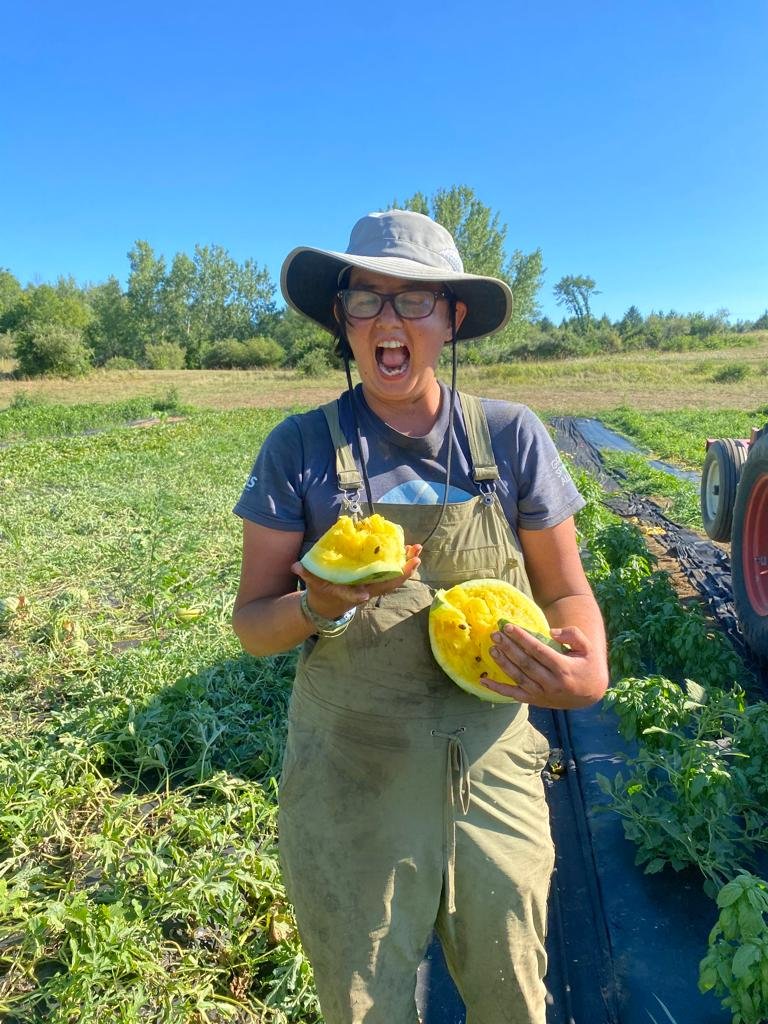2021 Pollinators Amanda and Alexx enjoying some cantaloupe.
What’s Below:
About Melons
Cooking & Storage
Recipes
ABOUT MELONS
Melons are deliciously juicy fruits that grow on bushy vines and are plant cousins of cucumber and squash. They have multiple points of origin across Africa and Southeast and West Asia where they’ve been cultivated for about 4,000-5,000 years. There are many types of melons that come in a variety of shapes and sizes, however the most well known ones are watermelons, cantaloupe, honey dew, and bittermelon.
Here at Rock Steady Farm we’re growing watermelons and cantaloupe which you can learn more about below.
D enjoying a cantaloupe.
Cantaloupe has origins across Southeast and West Asia, specifically India and Iran, where its been cultivated for at least 4,400 years. The word cantaloupe is believed to come from the Italian town of Cantalupo where it became popular thanks to a Pope being obsessed with it at the time. They’re also known as muskmelons which comes from the Persian word for perfume, and in India the Hindi word for melon is Kharbhuj खरभुज. All this is to say that there are many names for this sweet little fruit, that speak to its honey like scent and taste which has helped it maintain its popularity in Mediterranean and South West Asian cuisines to this day.
Mika enjoying some yellow watermelons!
Watermelons are native to Egypt and Libya, as well as Southern Africa, where they were first cultivated over 5,000 years ago and became valued for to their drought tolerance. Early watermelons had really bitter flesh and were most prized for their nutrient dense seeds. Overtime they would be bred to have a sweeter flesh surrounding the seeds, but the nutritious seeds have remained important especially in West African dishes like Egusi.
In the African diaspora of the Americas watermelon have come to symbolize liberation and joy for many Black people. And despite decades of harmful marketing campaigns, that are still somewhat pervasive in the minds of people today, many Black folks have resisted such stereotypes by continuing to both grow and enjoy the refreshment that watermelon has to offer.
COOKING & STORAGE
Edible parts: Fruit and seeds
Medicine and Nutrients: Both Watermelons and Cantaloupe are a great source of vitamins C and A, as well as potassium.
Storage: Melons can be kept at room temperature until they’re fully ripe, and when ripe they should be kept cool in the fridge. There’s lots of debate as to whether or not melons can ripen off the vine on their own, but if you place a melon in a paper bag with an apple or banana it will encourage the melon to ripen somewhat. Ripe melon slices or cubes can be stored in an airtight container or wrapping for about a week. Melons can also be cut up and stored in the freezer, which make a sweet alternative to ice cubes for drinks.
Ways to Prepare: Although the raw pulp of melons are the most popularly eaten part of the plant, their seeds are prized in some Black and Brown cultures (particularly West African and South East Asian cuisines) to make soups and stews, or toasted as a snack. The rinds of melons can also be cooked like winter squash, used to flavor dishes like soup, or brined to make a crunchy pickle.
RECIPES
Egusi Soup - Nigerian Melon Seed Stew (Low Carb Africa)
Wrewre (Melon Seed) Soup (video with ingredients listed)
Watermelon Rind Sabji (Chez Shuchi)
Watermelon Mint Popsicles (Jessica in the Kitchen)
Watermelon Feta Salad (Jessica in the Kitchen)
Cantaloupe Salad with Mint, Lime, and Pepitas (Feasting at Home)
Roasted Cantaloupe (Food52)
Glazed Cantaloupe Quick Bread (Amanda’s Cooking)
Authored and compiled by Maya Marie of Deep Routes









